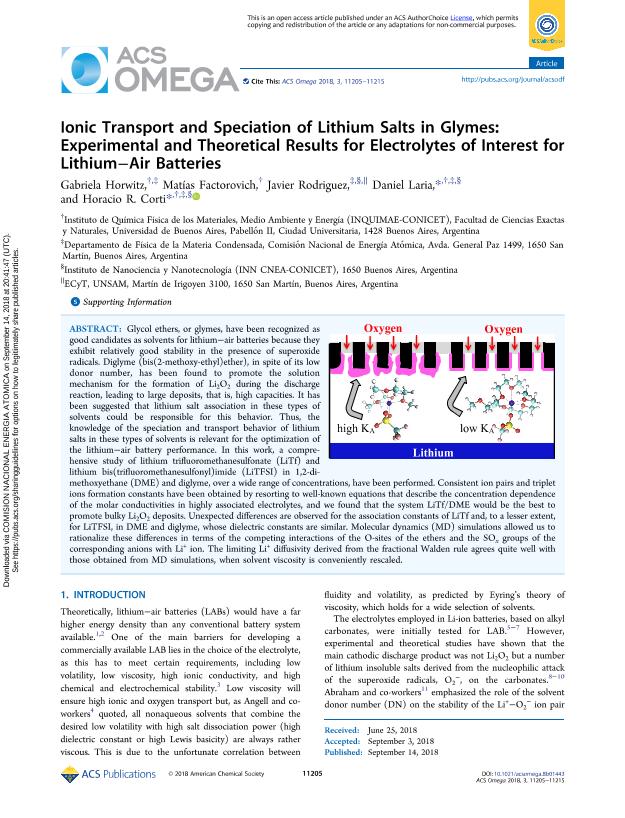Mostrar el registro sencillo del ítem
dc.contributor.author
Horwitz, Gabriela

dc.contributor.author
Factorovich, Matias Hector

dc.contributor.author
Rodriguez, Javier

dc.contributor.author
Laria, Daniel Hector

dc.contributor.author
Corti, Horacio Roberto

dc.date.available
2019-11-20T21:51:27Z
dc.date.issued
2018-09
dc.identifier.citation
Horwitz, Gabriela; Factorovich, Matias Hector; Rodriguez, Javier; Laria, Daniel Hector; Corti, Horacio Roberto; Ionic Transport and Speciation of Lithium Salts in Glymes: Experimental and Theoretical Results for Electrolytes of Interest for Lithium-Air Batteries; American Chemical Society; ACS Omega; 3; 9; 9-2018; 11205-11215
dc.identifier.issn
2470-1343
dc.identifier.uri
http://hdl.handle.net/11336/89329
dc.description.abstract
Glycol ethers, or glymes, have been recognized as good candidates as solvents for lithium-air batteries because they exhibit relatively good stability in the presence of superoxide radicals. Diglyme (bis(2-methoxy-ethyl)ether), in spite of its low donor number, has been found to promote the solution mechanism for the formation of Li2O2 during the discharge reaction, leading to large deposits, that is, high capacities. It has been suggested that lithium salt association in these types of solvents could be responsible for this behavior. Thus, the knowledge of the speciation and transport behavior of lithium salts in these types of solvents is relevant for the optimization of the lithium-air battery performance. In this work, a comprehensive study of lithium trifluoromethanesulfonate (LiTf) and lithium bis(trifluoromethanesulfonyl)imide (LiTFSI) in 1,2-di-methoxyethane (DME) and diglyme, over a wide range of concentrations, have been performed. Consistent ion pairs and triplet ions formation constants have been obtained by resorting to well-known equations that describe the concentration dependence of the molar conductivities in highly associated electrolytes, and we found that the system LiTf/DME would be the best to promote bulky Li2O2 deposits. Unexpected differences are observed for the association constants of LiTf and, to a lesser extent, for LiTFSI, in DME and diglyme, whose dielectric constants are similar. Molecular dynamics (MD) simulations allowed us to rationalize these differences in terms of the competing interactions of the O-sites of the ethers and the SOx groups of the corresponding anions with Li+ ion. The limiting Li+ diffusivity derived from the fractional Walden rule agrees quite well with those obtained from MD simulations, when solvent viscosity is conveniently rescaled.
dc.format
application/pdf
dc.language.iso
eng
dc.publisher
American Chemical Society

dc.rights
info:eu-repo/semantics/openAccess
dc.rights.uri
https://creativecommons.org/licenses/by-nc-sa/2.5/ar/
dc.subject
Litio
dc.subject
Diglimas
dc.subject
Conductividad Ionica
dc.subject
Dinamica Molecular
dc.subject.classification
Físico-Química, Ciencia de los Polímeros, Electroquímica

dc.subject.classification
Ciencias Químicas

dc.subject.classification
CIENCIAS NATURALES Y EXACTAS

dc.title
Ionic Transport and Speciation of Lithium Salts in Glymes: Experimental and Theoretical Results for Electrolytes of Interest for Lithium-Air Batteries
dc.type
info:eu-repo/semantics/article
dc.type
info:ar-repo/semantics/artículo
dc.type
info:eu-repo/semantics/publishedVersion
dc.date.updated
2019-10-16T15:25:01Z
dc.journal.volume
3
dc.journal.number
9
dc.journal.pagination
11205-11215
dc.journal.pais
Estados Unidos

dc.description.fil
Fil: Horwitz, Gabriela. Comisión Nacional de Energía Atómica; Argentina. Consejo Nacional de Investigaciones Científicas y Técnicas. Oficina de Coordinación Administrativa Ciudad Universitaria. Instituto de Química, Física de los Materiales, Medioambiente y Energía. Universidad de Buenos Aires. Facultad de Ciencias Exactas y Naturales. Instituto de Química, Física de los Materiales, Medioambiente y Energía; Argentina
dc.description.fil
Fil: Factorovich, Matias Hector. Consejo Nacional de Investigaciones Científicas y Técnicas. Oficina de Coordinación Administrativa Ciudad Universitaria. Instituto de Química, Física de los Materiales, Medioambiente y Energía. Universidad de Buenos Aires. Facultad de Ciencias Exactas y Naturales. Instituto de Química, Física de los Materiales, Medioambiente y Energía; Argentina
dc.description.fil
Fil: Rodriguez, Javier. Consejo Nacional de Investigaciones Científicas y Técnicas; Argentina. Comisión Nacional de Energía Atómica; Argentina. Universidad Nacional de San Martín. Escuela de Ciencia y Tecnología; Argentina
dc.description.fil
Fil: Laria, Daniel Hector. Consejo Nacional de Investigaciones Científicas y Técnicas. Oficina de Coordinación Administrativa Ciudad Universitaria. Instituto de Química, Física de los Materiales, Medioambiente y Energía. Universidad de Buenos Aires. Facultad de Ciencias Exactas y Naturales. Instituto de Química, Física de los Materiales, Medioambiente y Energía; Argentina. Comisión Nacional de Energía Atómica; Argentina
dc.description.fil
Fil: Corti, Horacio Roberto. Consejo Nacional de Investigaciones Científicas y Técnicas. Oficina de Coordinación Administrativa Ciudad Universitaria. Instituto de Química, Física de los Materiales, Medioambiente y Energía. Universidad de Buenos Aires. Facultad de Ciencias Exactas y Naturales. Instituto de Química, Física de los Materiales, Medioambiente y Energía; Argentina. Comisión Nacional de Energía Atómica; Argentina. Consejo Nacional de Investigaciones Científicas y Técnicas; Argentina
dc.journal.title
ACS Omega
dc.relation.alternativeid
info:eu-repo/semantics/altIdentifier/url/https://pubs.acs.org/doi/full/10.1021/acsomega.8b01443
dc.relation.alternativeid
info:eu-repo/semantics/altIdentifier/doi/https://doi.org/10.1021/acsomega.8b01443
Archivos asociados
